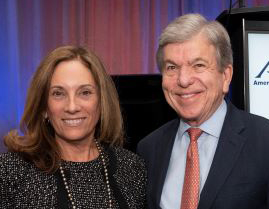Pat Harrison, Judy Woodruff and Senator Roy Blunt Discuss Democracy and Public Media at CPB Luncheon
March 5, 2023
From left, CPB Board Chair Laura Ross, Senator Roy Blunt, PBS NewsHour Special Correspondent Judy Woodruff, CPB President and CEO Pat Harrison, and CPB Board Vice Chair Ruby Calvert.
At a recent luncheon session sponsored by the Corporation for Public Broadcasting, CPB President and CEO Pat Harrison, former Senator Roy Blunt, and PBS NewsHour Special Correspondent Judy Woodruff talked about the state of our democracy and the critical role of public media.
Harrison opened the session by thanking public media stations for their leadership in providing the public with trusted, educational content, and fact-based journalism.
“Public media has a mission that matters, especially now in a world of emerging technologies, artificial intelligence, augmented reality, and media manipulation software that make it a challenge to separate facts from fake news,” Harrison said. "Public media connects to all audiences delivering authentic stories and not social media caricatures; through fact-based reporting and not misinformation and propaganda; and through content that speaks to what it means to be a citizen -- the rights and the responsibilities.”
Senator Blunt (R-MO), in a conversation with Woodruff, told the audience of public media leaders that in an increasingly fragmented society, public media must continue to provide diverse, informative content that people can’t get any other way

Blunt, who recently retired after serving for 26 years in Congress – 14 in the House and 12 in the Senate – discussed his career in public service and public media's role in connecting communities through educational and informational content.
Blunt acknowledged that communicating has become much more challenging than in the past as civility has declined. “I think a lot of what we see in our politics is more symptomatic of the way society has moved so quickly toward a level of intolerance and frankly sometimes meanness that we didn’t have when we were growing up,” he said. In Washington, Blunt was known for his bipartisan approach. Observing today’s political environment, he commented that “it does seem to me now that the performance standard has given way to the performative standard.”
Woodruff asked Blunt what public media can do to strengthen our civil society and our democracy. While Blunt recognized the very real challenges of misinformation and disinformation, he suggested that public media’s argument for federal funding that it just focuses on fact-based reporting may not resonate with some in Washington and around the country.
“You can all say public media is presenting the real facts, but not everybody believes it when you say it,” he said. “And not everybody believes it when I say it.”
“One of my colleagues told me: ‘It’s been a long time since anybody said, ‘That’s not what I think, but you know a lot more about this than I do.’ Almost nobody says that anymore. Everybody comes with their own facts.”

As a longtime supporter of public media in Congress, Blunt said that public media should not give up on the factual argument because it is the reason to have public media. But he shared with the audience that there is concern in Congress about some in public media having a one-sided perspective. He advised station leaders: “If you do present a program with a point of view, you really have to work to make sure the other point of view is heard.”
Blunt further spoke to the important mission of public media in serving unserved and underserved communities, including rural, minority, and families with different economic means. He commended public media for serving those Americans with content that helps them better their lives, keep their family safe, and thoughtfully engage in our civil society.
The diversity of programming that public media offers is vital to the unserved, people in rural areas, or those who can’t afford cable bills, he said. “Don’t forget who wouldn’t have the kind of choices and the kind of variety that public media brings. I would guess that’s about 20% of the population. Your argument is that you serve them too, so they have some of the same choices that others have.”
CPB continues to make investments to help public media stations connect to new audiences on the platform of their choice, support diverse and new storytellers to reflect the American public, and is increasing funding for content that fosters civic learning. “Increasingly, Americans understand it is up to each of us to work for the America we want, to strive for that more perfect union. And public media is the best partner to help us reach that goal,” Harrison concluded.
To subscribe to CPB spotlights, press releases and grant announcements, go to cpb.org/subscribe.





